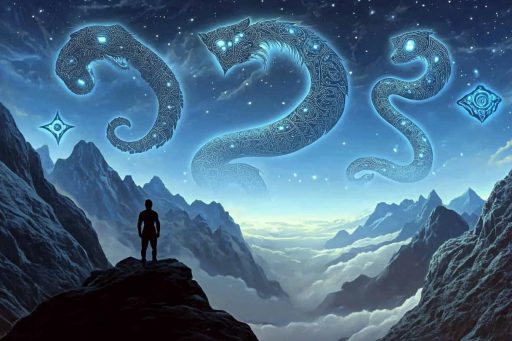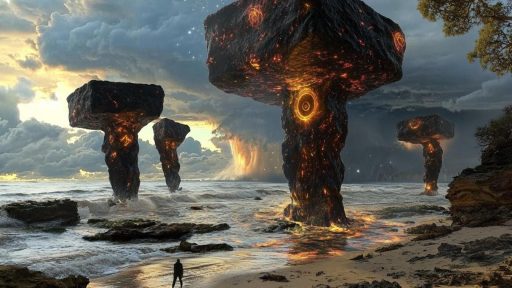
For thousands of years, humanity has looked to the stars not just for guidance, but for meaning. Across the ancient world, constellations became stories—cosmic tales of gods, monsters, heroes, and mysteries that reflected the deepest beliefs of each culture. Some of these myths still resonate today, while others remain unsolved enigmas, their true origins and meanings lost to time. What secrets did our ancestors see in the night sky—and why do some of those stories still haunt us?
The Binding of the Pleiades – Greece

The Pleiades star cluster is named after seven sisters from Greek mythology, pursued relentlessly by the hunter Orion. In the sky, they’re still being chased—but only six stars are easily visible, leading to speculation about the “lost” sister. Was this myth born from an ancient astronomical event, or does it point to forgotten cosmic knowledge? The mystery of the missing Pleiad continues to intrigue astronomers and mythologists alike.
The Emu in the Sky – Aboriginal Australia

Rather than connecting stars, Aboriginal Australians formed images from the dark spaces between them—most famously, the “Emu in the Sky.” Stretching across the Milky Way, the emu figure aligns with seasonal changes and cultural ceremonies. Yet how this knowledge was mapped so precisely remains unclear. It’s a striking reminder that ancient star lore wasn’t just spiritual—it was deeply practical and surprisingly sophisticated.
The Jaguar Constellation – Maya Civilization

The ancient Maya saw a powerful jaguar in the heavens, leaping across the night sky. This celestial feline symbolized the underworld, transformation, and the sacred cycle of life and death. Alignments with temples and ceremonial sites suggest they tracked the jaguar’s movements with precision. But the full scope of its role in Mayan astronomy remains a tantalizing mystery hidden in glyphs and ruins.
The Cosmic Turtle – Hindu Mythology

In Hindu cosmology, the world is supported by a great turtle swimming through the cosmic ocean—Kurma, a divine incarnation of Vishnu. Some interpretations tie this legend to the constellation Draco, winding like a celestial shell across the sky. Whether metaphor or memory of an ancient astronomical pattern, the turtle’s presence in the stars reflects a complex vision of time, balance, and rebirth. The origins of this myth may stretch further than we know.
The Milky Way as the River of Souls – Ancient Egypt

To the Egyptians, the Milky Way was not just a streak of stars—it was the celestial Nile, a river guiding souls to the afterlife. Linked to the goddess Nut, who arched over the Earth, this myth connected the stars to divine order and eternal life. But why this star path mirrored earthly geography so closely is still debated. Did they observe something more in the heavens than we can comprehend today?
The Bear in the Sky – Native American Traditions

Many Native American tribes, including the Iroquois and Lakota, saw a great bear in what we now call Ursa Major. The myth often features hunters chasing the bear across the seasons, with the constellation’s changing position marking the passage of time. These stories align closely with the cycle of nature, yet they also hint at deeper symbolic meanings—possibly even encoded knowledge of the cosmos. Their uncanny accuracy continues to astonish scholars.
The Archer of the Heavens – Sumerian Myth

Long before the Greeks called him Sagittarius, the figure of the archer appeared in Sumerian myths as a divine warrior. Some believe he was associated with Nergal, a god of war and plague, who patrolled the celestial realms. The bow pointed to unknown dangers lurking in the stars, perhaps even real cosmic events like comets or eclipses. Was this a warning woven into the night sky—or just a timeless story of vigilance?
The Serpent That Binds the Sky – Norse Mythology

Jörmungandr, the Midgard Serpent, is said to encircle the world, tail in mouth, waiting to unleash Ragnarok. Some scholars tie this myth to the twisting path of the Milky Way or to long-lost constellations. The serpent’s endless loop could symbolize time, fate, or cosmic catastrophe. Did the Norse see in the stars a glimpse of the universe’s eventual unraveling?
The Star Lovers – Japanese Tanabata Legend

In the Tanabata story, the stars Vega and Altair represent two lovers separated by the celestial river—the Milky Way. Allowed to meet only once a year, their tragic romance is still celebrated today with festivals and wishes hung on bamboo. Astronomers note the two stars’ brightness and seasonal positioning likely inspired the tale. But why this myth persists with such emotional power is a question no telescope can answer.
The Cosmic Canoe – Polynesian Voyagers

Polynesian navigators read the stars like a map, following constellations that formed a celestial canoe across the ocean sky. These myths were not just poetic—they were essential for survival, guiding long voyages between islands. Yet the exact methods of how they encoded this knowledge in stories remain a closely guarded secret. It’s a myth and a map, rolled into one extraordinary mystery of the sea and sky.
The Celestial Scorpion – Babylonian Lore

The Babylonians envisioned the constellation Scorpius as a monstrous creature guarding the path to immortality. Tied to the epic of Gilgamesh, the scorpion was a cosmic obstacle—deadly and divine. Its rising signaled intense heat and danger on Earth, blending astronomy with omens. Was this myth a metaphor for the limits of human reach—or a warning written in the stars?
When Stars Were Stories

Long before science mapped the universe, the stars were storytellers. They held memories, morals, and mysteries that shaped entire civilizations. Some myths guided crops, others warned of danger, and a few still defy all interpretation. Maybe these ancient cultures saw something in the night sky we’ve forgotten—something that refuses to be translated by data alone.





